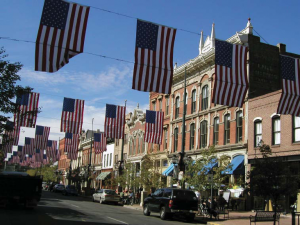Neighborhood Business District vs Shopping Center in Neighborhood
Author: Katlyn Cotton
Apr 08, 2008
Neighborhood Business District vs Shopping Center in Neighborhood

I learn from my clients — or sometimes their assignment forces me to learn for myself. This was recently the case in a trip to Boise, Idaho. I was invited by Terri Schorzman of COMPASS — the Community Planning Association of Southeast Idaho. Terri had invited me to make a presentation on property rights as part of a speaker series COMPASS is hosting. But since she was stuck paying for a day’s worth of my time, Terri contacted Katina Dutton, the development manager for Boise’s Capital City Development Corporation for how else I might spend my time. It turns out that the City of Boise and CCDC have been looking at strategies to enhance and revitalize 5 or 6 shopping centers located within Boise’s residential neighborhoods. Well, over the years I’ve worked in a number of neighborhood business districts around the country including Philadelphia, Chicago, Milwaukee, Oklahoma City, Albuquerque, Baltimore and elsewhere, so at first I thought, “No problem”. But then during my pre-visit discussions with Terri and Katina I realized that what they were describing in Boise were not really neighborhood business districts at all, but rather shopping centers that are located in neighborhoods. So I spent the weekend pondering what the differences between the two are. And here, for what it’s worth, is my list.
Neighborhood Business Districts (NBDs) usually have multiple building owners
Neighborhood Shopping Centers (NSCs) are usually a single owner
NBDs are pedestrian oriented
NSCs are automobile oriented
NBDs are predominately locally owned businesses
NSCs are predominately chain businesses (at least until they begin to decline)
NBDs are integrated with the residential neighborhood NSCs are isolated
NBDs are usually part of the urban grid
NSCs bear no relationship to the gird
NBDs include buildings that have been constructed over time
NSCs are built all at once
NBDs are often two and three story buildings
NSCs are nearly always one story buildings
NBDs often have functions beyond merely retail
NSCs are usually exclusively retail (until the center is declining, in which case the owner will take whomever comes along)
NBDs usually have only on street parking but lots of means of pedestrian access
NSCs have lots of asphalt parking but little convenient pedestrian access
The orientation of businesses in NBDs is external and on both sides of the street
The orientation of businesses in NSCs is either internal or on only one side
NBDs have an intense use of land
NSCs have an excess of land
NBDs can have a sense of community ownership, regardless of who the deed holders are
NSCs are seen as simply an investment of some Real Estate Investment Trust
The straetgy for declining NSCs is redevelopment
By its very nature, revitalization of NBDs is incremental
Redevelopment efforts of NSCs are often massive and comprehensive
Revitalization efforts in NBDs are usually private sector led and public sector supported
Redevelopment of NSCs is usually public sector led and private sector implemented

